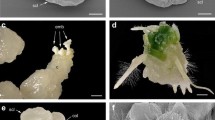Abstract
Interspecific hybridization between evergreen pot azalea (Tsutsusi) cultivars and genotypes of other Rhododendron subgenera or sections (Rhododendron, Hymenanthes, Pentanthera, Vireya) is significantly hampered by many prezygotic and postzygotic barriers. The objective of our work was to overcome spontaneous abortion and lack of endosperm formation and to increase germination rates by establishing an embryo rescue protocol. The optimal germination medium for immature Rhododendron seeds was a basal medium supplemented with 145 μM GA3. This medium induced germination of fertilized ovules after several sexual combinations of subgenera. Its use was clearly more efficient than in vivo sowing. The direction of the cross significantly influenced the occurrence of abortion, germination and albinism. The obtained seedlings were multiplied on Woody Plant Medium + 4.5 μM 2iP, and rooted afterwards. Finally, about 9% of the germinated ovules resulted in vigorously growing seedlings that were successfully acclimatized.


Similar content being viewed by others
Abbreviations
- 2iP:
-
Isopentenyladenine
- GA:
-
Gibberellic acid
- HY:
-
Subgenus Hymenanthes
- IAA:
-
Indole acetic acid
- MS:
-
Murashige & Skoog
- PE:
-
Subgenus Pentanthera
- RH:
-
Subgenus Rhododendron
- TS:
-
Subgenus Tsutsusi
- VI:
-
Section Vireya
References
Chamberlain D, Hyam G, Argent G et al (1996) The genus Rhododendron. Its classification & synonymy. Royal Botanical Garden Edinburgh
Cuevas J, Rallo L, Rapoport H et al (1994) Staining procedure for the observation of olive pollen tube behaviour. Acta Hort 356:264–267
De Jeu M (2000) In vitro techniques for ornamental breeding. Acta Hort 508:55–60
De Proft M, Maene L, Debergh P (1985) Carbon dioxide and ethylene evolution in the culture atmosphere of Magnolia cultured in vitro. Physiol Plant 65:375–379
Eeckhaut T, Van Laere K, De Riek J et al (2006) Overcoming interspecific barriers in ornamental plant breeding. In: Teixeira da, Silva J (eds) Floriculture, ornamental and plant biotechnology: advances and topical issues, 1st edn. Global Science Books, London, pp 540–551
Johnston S, Den Nijs T, Peloquin S et al (1980) The significance of gene balance to endosperm development in interspecific crosses. Theor Appl Genet 57:5–9
Kita K, Kurashige Y, Yukawa T et al (2005) Plastid Inheritance and Plastome-genome incompatibility of intergeneric hybrids between Menziesia and Rhododendron. J Japan Soc Hort Sci 74:318–323
Levin D (1978) The origin of isolating mechanisms in flowering plants. Evol Biol 11:185–197
Lloyd G, Mc Cown B (1980) Commercially-feasible micropropagation of mountain laurel, Kalmia latifolia, by use of shoot-tip culture. Proc Int Plant Prop Soc 30:421
Mertens M, Samyn G (1994) Regeneration and somaclonal variation of Rhododendron simsii offer prospects to the obtainment of commercially valuable sports. Mededelingen FLTBW RUG 59:2495–2497
Michishita A, Ureshino K, Miyajima I (2001) Shortening the period from crossing to the seedling stage through ovule culture of interspecific crosses of azalea (Rhododendron spp.). J Japan Soc Hort Sci 70:54–59
Murashige T, Skoog F (1962) A revised medium for rapid growth and bioassays with tobacco tissue cultures. Physiol Plant 15:473–497
Pickersgill B, Hayward M, Bosemark N et al (1993) Interspecific hybridization by sexual means. In: Hayward M, Bosemark N, Romagosa I (eds) Plant breeding: principles and prospects. Plant breeding series. Chapman and Hall, New York
Pierik R (1999) In vitro culture of higher plants. Kluwer Academic Publishers, Dordrecht
Preil W, Ebbinghaus R (1985) Bastardierungen von Topfazaleen (Rhododendron simsii) mit anderen Rhododendron-Arten. Rhododendron und immergrüne Laubgehölze, Jahrbuch pp 85–92
Rouse J (1993) Inter- and intraspecific pollinations involving Rhododendron species. J Amer Rhododendron Soc 47:23–45
Sharma D, Kaur R, Kumar K (1996) Embryo rescue in plants - a review. Euphytica 89:325–337
Sharma H (1995) How wide can a wide cross be? Euphytica 82:43–64
Ureshino K, Miyajima I, Akabane M (1998) Effectiveness of three-way crossing for the breeding of yellow-flowered evergreen azalea. Euphytica 104:113–118
Ureshino K, Kawai M, Miyajima I (2000) Factors of unilateral cross incompatibility between several evergreen azalea species and Rhododendron japonicum flavum. J Japan Soc Hort Sci 69:261–265
Van Tuyl J, De Jeu M (1997) Methods for overcoming interspecific crossing barriers. In: Shivanna K, Sawhney V (eds) Pollen biotechnology for crop production and improvement. University Press, Cambridge, pp 273–292
Van Tuyl J, Van Dien M, Van Creij M et al (1991) Application of in vitro pollination, ovary culture, ovule culture and embryo rescue for overcoming incongruity barriers in interspecific Lilium crosses. Plant Sci 74:115–116
Williams E, Rouse J, Kaul V et al (1991) Reproductive timetable for the tropical Vireya rhododendron R. macgregoriae. Sexual Plant Reprod 4:155–165
Zenkteler M (1990) In vitro fertilization and wide hybridization in higher plants. Critical Rev Plant Sci 9:267–279
Acknowledgements
This work was financed by DWTC-Belgium. The authors wish to thank Romain Uytterhaegen, Ronald Van den Oord, Kristien Janssens, Veerle Cools and Laurence Desmet for technical assistance.
Author information
Authors and Affiliations
Corresponding author
Rights and permissions
About this article
Cite this article
Eeckhaut, T., De Keyser, E., Van Huylenbroeck, J. et al. Application of embryo rescue after interspecific crosses in the genus Rhododendron . Plant Cell Tiss Organ Cult 89, 29–35 (2007). https://doi.org/10.1007/s11240-007-9209-4
Received:
Accepted:
Published:
Issue Date:
DOI: https://doi.org/10.1007/s11240-007-9209-4




